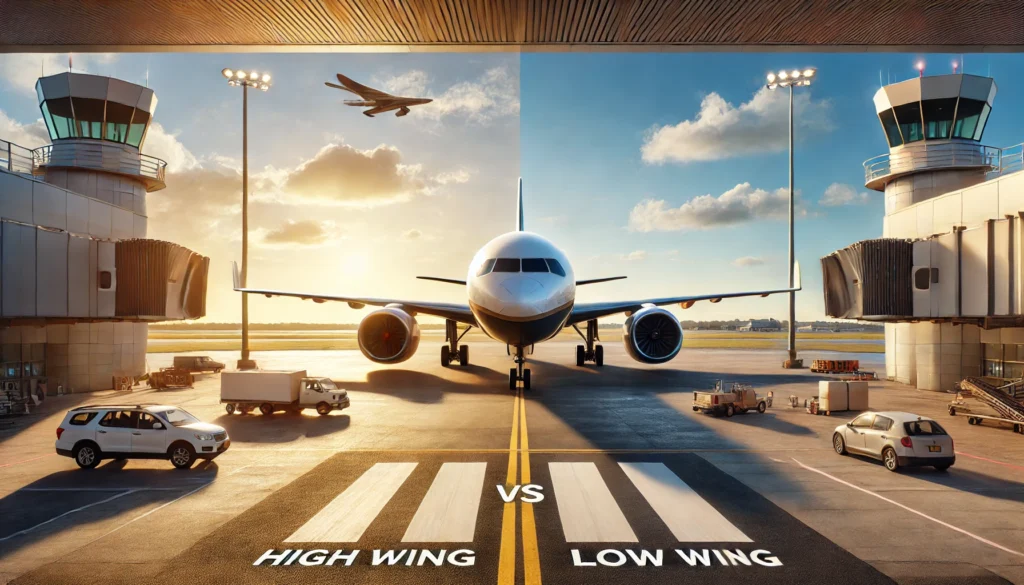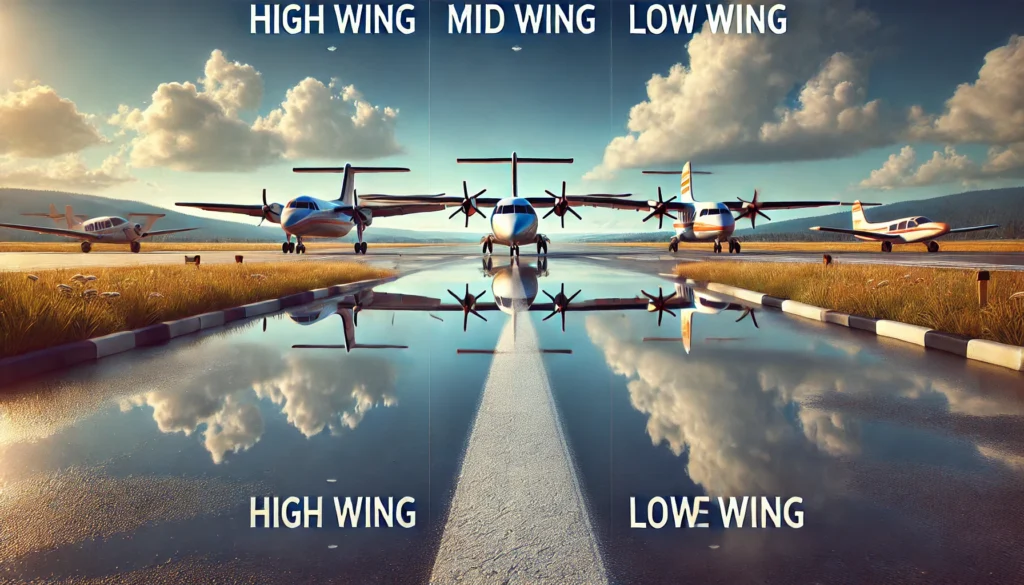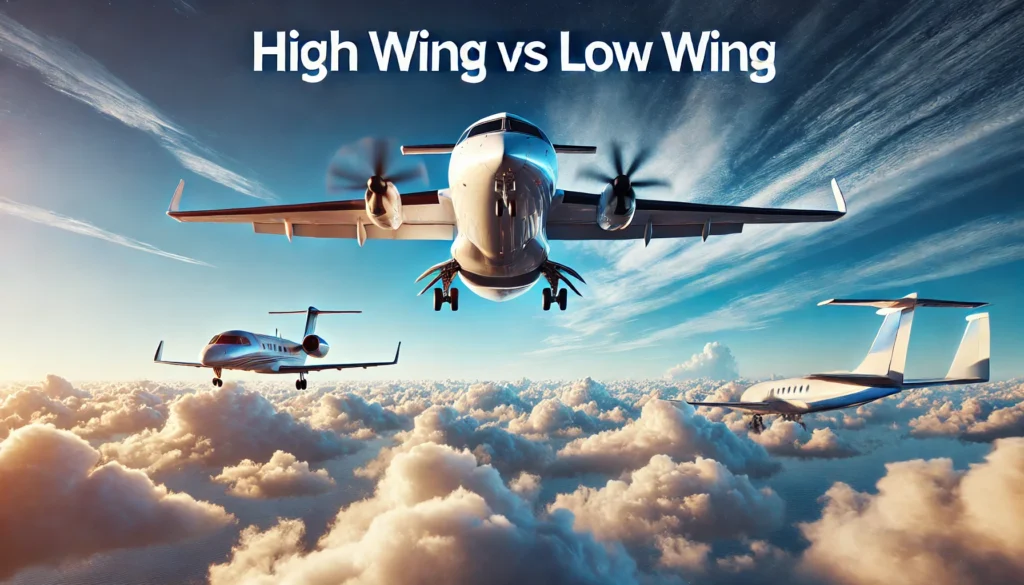Welcome to Wings Over Clouds, your trusted source for all things aviation. Today, we’ll dive deep into the debate of high wing vs low wing aircraft. This topic is essential for anyone in the aviation industry, whether you’re a student pilot, an aviation enthusiast, or a seasoned professional. Moreover, By the end of this article, you’ll have a thorough understanding of the differences, advantages, and disadvantages of both wing configurations.
Understanding Wing Configurations
What is a High Wing Aircraft?
A high wing aircraft has its wings mounted on the fuselage. Moreover, This configuration is popular among many general aviation and military aircraft.
What is a Low Wing Aircraft?
Conversely, a low wing aircraft has its wings attached at the bottom of the fuselage. This setup is often seen in commercial airliners and many light aircraft.
High Wing vs Low Wing: Key Differences
Aerodynamics
In terms of aerodynamics, high wing vs low wing aircraft exhibit distinct characteristics. High wing aircraft tend to have better stability, making them ideal for low-speed flight and rough field operations. Low wing aircraft generally offer better roll rates and are often more efficient at higher speeds.
Aspect Ratio
The aspect ratio, which is the wingspan divided by the wing chord, plays a significant role in aircraft performance. High vs low aspect ratio wing configurations impact lift and drag differently. High aspect ratio wings (long and slender) are efficient for gliding and long-range flights, while low aspect ratio wings (short and stubby) are better for maneuverability and structural strength.
Wing Loading
Wing loading is the ratio of an aircraft’s weight to its wing area. High wing loading vs low wing loading affects performance in various ways. High wing loading provides smoother rides in turbulent conditions and is typical in faster, more powerful aircraft. Moreover, Low wing loading found in gliders and some light aircraft, allows for better lift and slower stall speeds.
High Wing vs Low Wing Aircraft: Pros and Cons

Advantages of High Wing Aircraft
- Better Visibility: High-wing aircraft offer excellent downward visibility, crucial for spotting landmarks and obstacles during flight.
- Ground Clearance: With wings positioned high, there is more clearance from ground obstacles, making them suitable for rough or unprepared runways.
- Stability: The center of gravity is lower relative to the wings, providing greater stability, especially in turbulence.
Disadvantages of High Wing Aircraft
- Access: Boarding and exiting can be more challenging without proper ladders or steps.
- Performance: Generally, high-wing aircraft have slightly lower cruise speeds due to increased drag.
Advantages of Low Wing Aircraft
- Performance: Low wing aircraft typically achieve higher speeds and better aerodynamic efficiency.
- Ground Handling: Easier access to the cabin and easier maintenance due to the lower position of the wings.
- Roll Rate: Better roll rate and maneuverability, which is beneficial for aerobatic flying and some military applications.
Disadvantages of Low Wing Aircraft
- Visibility: Downward visibility is reduced, which can be a drawback in certain flight operations.
- Ground Clearance: Lower wings mean more risk of damage from debris or rough terrain.
High Wing vs Mid Wing vs Low Wing: A Comparison

Mid Wing Aircraft
A mid wing aircraft has its wings mounted mid-fuselage. This configuration offers a balance between high and low wing designs. Mid wing designs are rare but provide excellent maneuverability and balance, often seen in high-performance military jets.
High Wing vs Mid Wing vs Low Wing: Comparison Chart
| Feature | High Wing | Mid Wing | Low Wing |
|---|---|---|---|
| Stability | High | Moderate | Low |
| Maneuverability | Moderate | High | High |
| Visibility | Excellent downward | Balanced | Excellent upward |
| Ground Clearance | High | Moderate | Low |
| Maintenance Access | Moderate | Difficult | Easy |
| Cruise Speed | Moderate | High | High |
High Wing vs Low Wing Aerodynamics: In-Depth Analysis
Lift and Drag
Lift and drag are critical factors in aerodynamics. High wing aircraft generally create more lift at lower speeds, which is advantageous for short takeoff and landing (STOL) operations. Low wing aircraft, with their cleaner aerodynamics, tend to have less drag, enhancing their performance at higher speeds.
Stability and Control
Stability is a hallmark of high wing designs, making them forgiving for new pilots. Low wing aircraft, while less inherently stable, offer better control responsiveness, favored by experienced pilots and in applications requiring precise maneuvering.
High Wing vs Low Wing Planes: Practical Considerations
Usage Scenarios
- Bush Flying: High wing aircraft are preferred for bush flying due to their robustness and ability to operate from rough airstrips.
- Training: Many flight schools use high wing aircraft for primary training because of their forgiving nature.
- Commercial Aviation: Most commercial airliners are low wing to maximize passenger capacity and fuel efficiency.
- Recreational Flying: Low wing planes are popular for recreational flying due to their sporty handling characteristics.
Cost Implications
High wing aircraft may incur higher maintenance costs due to more complex access requirements for inspections and repairs. Moreover, Low wing aircraft often have simpler access, potentially reducing maintenance time and costs.
High Wing Aircraft vs Low Wing: Making the Right Choice
Choosing between a high wing and low wing aircraft depends on your specific needs and preferences. Consider factors such as the typical flying environment, intended use, and personal comfort with the aircraft’s handling characteristics.
FAQs About High Wing vs Low Wing
What are the key differences in performance between high wing and low wing aircraft?
High-wing aircraft excel in stability and low-speed performance, ideal for short takeoff and landing operations. Low-wing aircraft offer better speed, efficiency, and roll rates, making them suitable for faster, more dynamic flying.
Which type of aircraft is better for rough field operations?
High-wing aircraft are generally better suited for rough field operations due to their increased ground clearance and robust design.
How does wing loading affect aircraft performance?
High wing loading results in smoother rides and is common in faster aircraft, while low wing loading allows for better lift and slower stall speeds, beneficial for gliders and light aircraft.
Are there any significant differences in maintenance between high wing and low wing aircraft?
Yes, high-wing aircraft may require more complex access for maintenance, potentially increasing costs, whereas low-wing aircraft typically offer easier access, simplifying maintenance tasks.
What should I consider when choosing between a high wing and low wing aircraft?
Consider your typical flying environment, intended use, handling preferences, and specific performance needs.
High Wing vs Low Wing “Final Thoughts”
In the debate of high wing vs low wing aircraft, there is no one-size-fits-all answer. Each configuration has its unique advantages and disadvantages, making them suitable for different applications and pilot preferences. Whether you prioritize stability and visibility or speed and maneuverability, understanding these key differences will help you make an informed decision. At Wings Over Clouds, we’re committed to providing you with the knowledge you need to navigate the skies confidently. Visit us at Wings Over Clouds for more aviation insights and resources.
By considering factors such as aerodynamics, wing loading, aspect ratio, and practical usage scenarios, you can better understand the nuances of high wing vs low wing aircraft. Furthermore, Remember the best aircraft is the one that meets your specific needs and enhances your flying experience. Moreover, also do check out our latest product range. Safe flying!

